Beginners Guides
What Are The Tiny Black Flies In My House
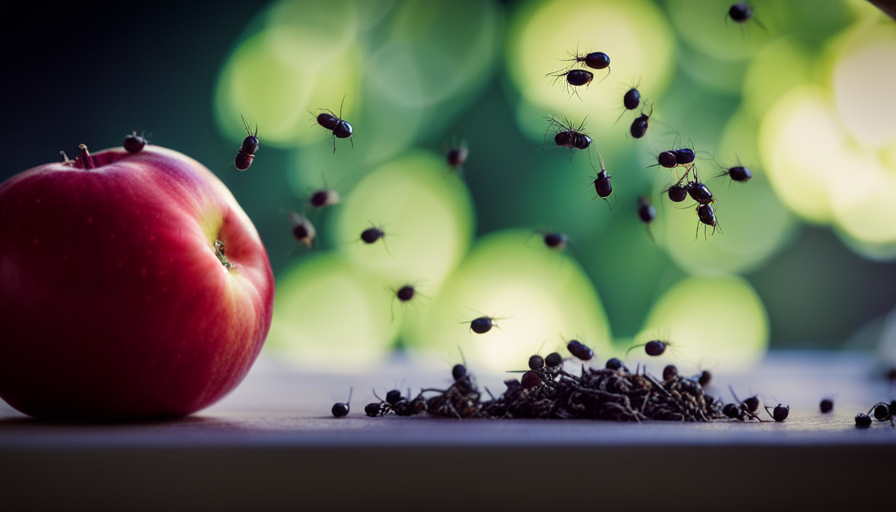
Have you ever been caught trying to swat away those irritating small flies that hover around your home? I definitely have! It’s quite bothersome, right? But worry no more, because I’ve arrived to unravel the enigma of these small black flies and assist you in resolving your buzzing issue.
In this informative article, we will explore the different types of tiny black flies that may be infesting your home. By understanding their characteristics and habits, we can better identify the source of the infestation. We’ll also discuss various prevention measures you can take to keep these flies at bay, as well as natural remedies and chemical solutions for those persistent critters.
If you’re feeling overwhelmed and nothing seems to work, don’t worry – I’ll provide some guidance on when it’s time to call in the professionals. So, let’s dive in and uncover the secrets of those tiny black flies that seem to have taken up residence in our humble abodes.
Together, we’ll conquer this buzzing nuisance once and for all!
Key Takeaways
- Tiny black flies in the house belong to the family Drosophilidae and are commonly found in overripe fruits, unwashed produce, and moist soil.
- To identify the source of infestation, check for overripe fruits and vegetables, damp organic matter, and standing water.
- Prevention measures include removing and disposing of rotten produce, properly disposing of organic matter, and regularly cleaning and drying water sources.
- Natural remedies such as homemade traps, essential oils, and vinegar and dish soap solutions are effective in repelling and eliminating tiny black flies.
Types of Tiny Black Flies
Hey, ever wonder what those pesky little black flies in your house are? Well, there are various types of tiny black flies that can invade our living spaces. These flies belong to the family Drosophilidae, which includes fruit flies and fungus gnats. Understanding their lifecycle stages and common breeding grounds can help us identify the source of infestation.
The lifecycle of these flies consists of four stages: egg, larva, pupa, and adult. Eggs are usually laid in moist organic matter, such as decaying fruits, vegetables, or damp soil. After hatching, the larvae feed on the organic material and undergo several molts before entering the pupal stage. Once the pupae develop, adult flies emerge and begin their quest for food and breeding.
Common breeding grounds for these tiny black flies include overripe fruits, unwashed produce, and moist soil. Fruit flies are particularly attracted to fermented fruits, while fungus gnats thrive in damp areas with decaying plant matter. It’s important to eliminate these breeding grounds to prevent further infestations.
Understanding the lifecycle and common breeding grounds of these tiny black flies can help us identify the source of infestation and take appropriate measures to eliminate them from our homes. Now, let’s dive into the next section and learn more about identifying the source of infestation.
Identifying the Source of Infestation
To identify where these pesky critters are coming from, take a closer look at the potential sources of infestation. Here are the common breeding grounds for tiny black flies:
-
Overripe fruits and vegetables: These flies are attracted to the fermenting sugars in overripe fruits and vegetables, making them a common breeding ground. Check your fruit bowls and vegetable bins for any rotten produce.
-
Damp organic matter: Tiny black flies thrive in moist environments, such as decaying plants, wet soil, or compost piles. Inspect your houseplants, flowerpots, and any areas where organic matter may be decomposing.
-
Standing water: Stagnant water can serve as a breeding site for these flies. Look for any water sources that have been left undisturbed, such as pet water bowls, potted plant saucers, or clogged drains.
To eliminate breeding sites and prevent further infestation, consider the following steps:
-
Remove and dispose of overripe fruits and vegetables promptly.
-
Properly dispose of organic matter and maintain dry conditions in and around your home.
-
Regularly clean and dry water sources to prevent standing water.
By addressing these potential breeding grounds, you can significantly reduce the population of tiny black flies in your house. Now, let’s move on to the next section and discuss prevention measures to keep these flies away for good.
Prevention Measures
One effective way to keep these pesky insects away for good is by implementing prevention measures. By taking proactive steps, you can create an environment that discourages the growth and presence of tiny black flies in your house. Incorporating natural deterrents and maintaining regular cleaning routines are two key strategies to prevent infestations.
To begin, let’s explore some natural deterrents that can help repel these flies. The table below highlights three effective options:
| Natural Deterrents | How to Use | Benefits |
|---|---|---|
| Citronella | Use candles or essential oil in strategic areas | Repels flies and other insects |
| Peppermint | Place dried peppermint leaves in infested areas | Strong aroma deters flies |
| Vinegar | Create a vinegar trap by mixing vinegar and dish soap | Traps and kills flies |
In addition to natural deterrents, maintaining a clean and tidy house is crucial. Flies are attracted to dirt, food residue, and moist environments. Regularly clean your kitchen, dispose of garbage properly, and keep food stored in sealed containers. By doing so, you can minimize potential breeding grounds and discourage the presence of these pesky insects.
Next, we will explore natural remedies that can effectively eliminate existing infestations.
Natural Remedies
In my research on natural remedies to deal with tiny black flies in my house, I’ve come across several effective methods. Homemade traps can be made using simple materials like a plastic bottle and apple cider vinegar, which lures the flies into the trap.
Essential oils, such as lavender or eucalyptus, can also be used to repel the flies since they dislike the strong scent.
Additionally, a solution made with vinegar and dish soap can be sprayed on surfaces to kill and deter the flies.
Lastly, reducing moisture levels in the house can make it less attractive to these flies since they are often attracted to damp areas.
Homemade traps
Try using a homemade trap to catch those pesky tiny black flies buzzing around your house like a fly to honey. Homemade traps are an effective and natural way to control the population of these annoying insects.
To make a simple trap, you’ll need a jar, apple cider vinegar, dish soap, and plastic wrap. First, pour a small amount of apple cider vinegar into the jar and add a few drops of dish soap. The vinegar will attract the flies, while the dish soap will make them unable to escape.
Cover the jar with plastic wrap and poke a few small holes in it. Place the trap in areas where you have noticed the most fly activity. The flies will be lured in by the scent of the vinegar and become trapped inside the jar.
This homemade trap is a cost-effective and eco-friendly alternative to DIY fly repellents and fly larvae control.
Transitioning into the next section, essential oils can also be used to repel these flies in a natural and effective way.
Essential oils
Harness the power of essential oils to banish those pesky pests and transform your home into a fragrant sanctuary. Essential oils have long been utilized for their aromatherapy benefits, and they can also serve as a natural way to deter flies. By using essential oil diffusers strategically placed throughout your house, you can effectively repel those tiny black flies. Certain essential oils, such as lavender, peppermint, and eucalyptus, are particularly effective in warding off insects. These oils emit strong scents that flies find unpleasant, causing them to steer clear of your living space. Additionally, essential oils have the added benefit of creating a calming and inviting atmosphere in your home. So, why not harness the power of nature’s scents to keep those flies at bay? Transitioning into the next section, another method that can prove useful is a vinegar and dish soap solution.
Vinegar and dish soap solution
To effectively tackle those pesky flying insects, whip up a powerful solution using vinegar and dish soap. This simple yet effective remedy is a natural and non-toxic way to get rid of fruit flies and fungus gnats in your house.
The acidic nature of vinegar helps to repel these tiny black flies, while the dish soap acts as a surfactant to break the surface tension of the solution, making it easier for the flies to drown.
- Mix equal parts of vinegar and water in a spray bottle.
- Add a few drops of dish soap to the mixture.
- Shake well to combine all the ingredients.
Spray this solution in areas where you have noticed the presence of fruit flies or fungus gnats. The vinegar will act as a deterrent and the dish soap will ensure that the flies are trapped and unable to escape. This solution is an effective way to eliminate these annoying insects.
Reducing moisture levels in your home is another crucial step to prevent the reoccurrence of these flies.
Reducing moisture levels
One way you can reduce moisture levels in your home is by using a dehumidifier, which can lower the humidity levels by up to 50%. A dehumidifier works by drawing in moist air, cooling it, and then collecting the water vapor as condensation. This helps to remove excess moisture from the air, making your home less hospitable to tiny black flies and other pests that thrive in humid environments.
To further prevent moisture buildup, consider implementing ventilation solutions. Properly ventilating your home can help to circulate air and reduce humidity levels. This can be achieved by opening windows, using exhaust fans in kitchens and bathrooms, and ensuring that air vents are unblocked. By reducing moisture levels and improving ventilation, you can create an environment that is less favorable for the growth of these flies.
Next, we will explore chemical solutions to address the issue of tiny black flies in your home.
Chemical Solutions
There’s a chemical spray you can use to get rid of those tiny black flies in your house. Chemical solutions are effective in eliminating these pests, but it’s important to use them safely and responsibly. Here are some key points to consider when using chemical solutions for fly control:
-
Choose a pesticide alternative: There are various insect repellents available in the market that are specifically designed to target flies. Look for products that contain active ingredients like pyrethrin or pyrethroid, as they’re known to effectively repel and kill flies.
-
Follow the instructions: Read and follow the instructions provided by the manufacturer carefully. This’ll ensure that you use the chemical spray correctly and get the desired results. Using too much or too little of the product may not yield the desired effect.
-
Take necessary precautions: Wear protective clothing, such as gloves and a mask, when applying the chemical spray. Keep children and pets away from the treated area until it’s safe to re-enter. Additionally, ensure proper ventilation to avoid inhaling the chemicals.
-
Consider professional help: If the infestation persists despite your efforts, it may be time to consider hiring a pest control professional. They have the knowledge and expertise to effectively eliminate the flies and prevent future infestations.
By following these guidelines, you can effectively use chemical solutions to combat the tiny black flies in your house. However, if the problem persists, it may be wise to seek the assistance of a pest control professional for a more comprehensive solution.
Hiring a Pest Control Professional
After considering chemical solutions for dealing with the tiny black flies in my house, I’ve decided to explore the option of hiring a pest control professional.
While chemical solutions can be effective, they often require repeated applications and may not completely eliminate the infestation. Additionally, I’m concerned about the potential health risks associated with these chemicals.
By hiring a pest control professional, I hope to address the root cause of the issue and ensure a more thorough eradication of the tiny black flies.
One important factor to consider when hiring a professional is the cost. While it may seem expensive initially, the long-term effectiveness of their services can make it a worthwhile investment.
Pest control professionals have the knowledge and expertise to identify the source of the infestation and implement targeted solutions. They use a combination of techniques, such as inspection, trapping, and insecticide application, to effectively eliminate the tiny black flies and prevent future outbreaks.
Furthermore, pest control professionals have access to specialized equipment and products that aren’t available to the general public. This allows them to tackle the infestation more effectively and efficiently.
Hiring a pest control professional can be a cost-effective and efficient solution for eradicating tiny black flies. Their expertise, specialized equipment, and targeted approach can ensure a more successful elimination of the infestation.
Frequently Asked Questions
How long do these tiny black flies typically live?
The lifespan of tiny black flies can vary depending on several factors. These include environmental conditions, availability of food and water, and the presence of predators.
Can these flies transmit any diseases to humans or pets?
These tiny black flies can transmit diseases to humans and pets, posing health risks. Prevention measures include proper sanitation, eliminating breeding sites, and using insecticides. It is important to take precautions to avoid potential disease transmission from these flies.
Are there any specific plants or foods that attract these flies?
Specific plants that attract tiny black flies include overripe fruits, decaying vegetables, and damp soil. Foods that can attract them are sugary substances, such as spilled juices or soda.
Can these flies cause damage to furniture or household items?
These flies do not cause damage to furniture or household items. However, they can affect indoor air quality. To prevent infestation, keep your house clean, remove any decaying organic matter, and use fly traps or insecticides if necessary.
Are there any specific signs or indicators of a severe infestation that I should be aware of?
Severe infestation indicators include a sudden increase in fly population, finding larvae or pupae, and multiple breeding sites. To effectively get rid of tiny black flies, clean and remove organic matter, use traps, and maintain good hygiene practices.
Conclusion
In conclusion, dealing with tiny black flies in the house can be a frustrating experience. However, by identifying the source of infestation and implementing prevention measures, such as keeping the house clean and dry, one can effectively control these pests.
Interestingly, according to a study conducted by the National Pest Management Association, tiny black flies are commonly attracted to moist and decaying organic matter, making it crucial to eliminate such sources to prevent infestations.
If the problem persists, it’s advisable to consult a pest control professional for assistance.
Hi, I’m Emma. I’m the Editor in Chief of Tiny House 43, a blog all about tiny houses. While tree houses are often associated with childhood, they can be the perfect adult retreat. They offer a cozy space to relax and unwind, surrounded by nature. And since they’re typically built on stilts or raised platforms, they offer stunning views that traditional homes simply can’t match. If you’re looking for a unique and romantic getaway, a tree house tiny house might just be the perfect option.
Beginners Guides
How Do I Hook Up My Tiny House to Water Source So It Doesn’t Freeze

So, you’ve got yourself a cute little tiny house, huh? Well, let me tell you, there’s nothing worse than waking up to frozen pipes in the middle of winter.
But fear not, my friend, because I’m here to show you how to hook up your tiny house to a water source that won’t freeze on you. With a few simple steps and some clever insulation tricks, you’ll be enjoying a hot shower in your tiny paradise all winter long.
Let’s get started, shall we?
Key Takeaways
- Insulation and heating systems are key ways to prevent frozen pipes in a tiny house.
- Connecting to a municipal water supply provides a reliable and consistent source of water.
- Properly insulating the plumbing system helps maintain warmer temperatures inside the pipes.
- Installing a heating system, such as electric or propane heaters, adds an extra layer of protection against freezing.
Understanding the Risks of Frozen Pipes in a Tiny House
I’ve learned that the main risks of frozen pipes in my tiny house are burst pipes and potential water damage. Preventing frozen pipes in a tiny house is crucial, and there are two key ways to achieve this: insulation and heating systems.

Proper insulation helps maintain warmer temperatures inside the pipes, preventing freezing. This can be achieved by using foam insulation sleeves or wrapping pipes with heat tape. Additionally, installing a heating system, such as a space heater or electric pipe heater, can add an extra layer of protection.
Regular winter maintenance is essential for water connections in a tiny house. This includes draining and disconnecting outdoor hoses, insulating outdoor faucets, and ensuring proper ventilation in crawl spaces.
Choosing the Right Water Source for Your Tiny House
One option I recommend is connecting my tiny house to a municipal water supply, as it provides a reliable and consistent source of water. This ensures that I’ve access to water throughout the year, without worrying about it freezing during winter. Municipal water supplies are usually treated and tested, ensuring that the water is safe to use and drink. Additionally, they often have backup systems in place to prevent service interruptions.
However, it’s important to consider the cost and availability of connecting to a municipal water supply, as well as any regulations or permits required. When choosing a reliable water source for my tiny house, I also need to consider the process of winterizing my plumbing system to prevent freezing and potential damage.

Insulating Your Plumbing System to Prevent Freezing
To prevent freezing, I’ll need to insulate both the pipes and the walls surrounding them. Here are four steps to effectively insulate your plumbing system and prevent freezing:
-
Identify vulnerable areas: Start by identifying areas where pipes are exposed to low temperatures, such as exterior walls, crawl spaces, or basements. These areas are more prone to freezing.
-
Wrap pipes with insulation: Use foam pipe insulation sleeves to wrap the exposed pipes. This will provide a layer of insulation and minimize heat loss. Make sure to cover all joints and fittings.
-
Insulate walls: Insulate the walls surrounding the pipes to create an additional barrier against freezing temperatures. Use insulation material like fiberglass or foam board insulation.

-
Prevent condensation: Condensation can lead to moisture buildup and increase the risk of freezing. To prevent condensation, consider using heat tape on the pipes. Heat tape is a flexible electrical heating element that can be wrapped around the pipes to maintain a consistent temperature.
Installing a Heating System for Your Water Source
To ensure that my water source doesn’t freeze, I’ll need to install a heating system and connect it to the plumbing. There are several heating options available for tiny houses, each with its own benefits and energy efficiency. Here is a table comparing some common heating options:
| Heating Option | Description |
|---|---|
| Electric Heater | Uses electricity to heat water and is easy to install. However, it can be costly to operate. |
| Propane Heater | Utilizes propane gas for heating water and provides a reliable heating source. It is energy-efficient and suitable for off-grid living. |
| Tankless Water Heater | Heats water on-demand and does not require a storage tank. It is energy-efficient and saves space. |
| Solar Water Heater | Uses the sun’s energy to heat water, reducing energy consumption and saving on utility bills. However, it requires ample sunlight. |
Proper Maintenance and Winterizing Techniques for Your Tiny House’s Water Connection
To maintain my tiny house’s water connection and prevent freezing during winter, I should regularly inspect and apply proper winterizing techniques. Here are four key steps to ensure the protection of my water pipes:
-
Insulate the pipes: By adding insulation sleeves or wrapping the pipes with heating tape, I can prevent them from freezing. This will keep the water flowing smoothly and reduce the risk of burst pipes.

-
Seal any gaps or cracks: I should thoroughly inspect the areas where the pipes enter the house and seal any gaps or cracks. This will prevent cold air from entering and keep the pipes warm.
-
Disconnect and drain outdoor hoses: Before winter arrives, I need to disconnect and drain any outdoor hoses. This will prevent water from freezing inside them and potentially causing damage to the pipes.
-
Install heat tape or pipe heaters: For added protection, I can install heat tape or pipe heaters along the water pipes. These devices provide consistent heat and prevent freezing.
Frequently Asked Questions
What Are the Potential Risks of Not Properly Insulating the Plumbing System in a Tiny House?
Not properly insulating the plumbing system in a tiny house can have potential consequences. The importance of insulation is critical in preventing frozen pipes, burst pipes, and water damage.

Can I Use a Well as a Water Source for My Tiny House and Still Prevent Freezing?
Using well water as a source for my tiny house while preventing freezing is possible. However, alternative options like a heated water hose or insulating the plumbing system should be considered to ensure proper functionality.
Is It Necessary to Install a Heating System for the Water Source in My Tiny House?
Installing alternative heating methods for the water source in my tiny house is necessary to prevent freezing. Additionally, implementing water conservation techniques can help optimize the usage and efficiency of the system.
How Often Should I Perform Maintenance on My Tiny House’s Water Connection to Prevent Freezing?
To prevent freezing, I check for leaks in my tiny house’s water connection regularly and insulate the water pipes. Maintenance is crucial, so I perform these tasks at least once a month.
Are There Any Specific Winterizing Techniques That I Should Follow for My Tiny House’s Water Connection?
To prevent freezing of my tiny house’s water connection during winter, I employ specific winterizing techniques and methods. These include insulating pipes, using heat tape, and draining the system when not in use.

Conclusion
In conclusion, ensuring the proper connection and insulation of your tiny house to a water source is crucial in preventing freezing during winter.
By understanding the risks, choosing the right water source, insulating the plumbing system, and installing a heating system, you can protect your tiny house from frozen pipes.
Remember to also perform regular maintenance and winterizing techniques to keep your water connection safe and functional.
Keep your tiny house warm and worry-free this winter!

I’m Theodore, and I love tiny houses. In fact, I’m the author of Tiny House 43, a book about tiny houses that are also tree houses. I think they’re magical places where imaginations can run wild and adventures are just waiting to happen.
While tree houses are often associated with childhood, they can be the perfect adult retreat. They offer a cozy space to relax and unwind, surrounded by nature. And since they’re typically built on stilts or raised platforms, they offer stunning views that traditional homes simply can’t match.
If you’re looking for a unique and romantic getaway, a tree house tiny house might just be the perfect option.
Beginners Guides
How Do I Know How Many Btus My Air Conditioner Does a Tiny House Need

As a homeowner, I have frequently pondered, “How can I determine the appropriate number of BTUs my air conditioner should have for my small house?” This is a common yet essential question. Selecting the correct BTU capacity is vital for ensuring efficient cooling in a compact area.
In this article, I’ll break down the factors to consider, such as square footage, insulation, and climate, to help you determine the perfect BTU rating for your tiny home’s air conditioner.
So, let’s dive in and find the answer together.
Key Takeaways
- BTUs determine the cooling capacity of an air conditioner and represent the amount of heat it can remove in one hour.
- Factors such as the size of the house, insulation levels, number of windows, ceiling height, and room layout should be considered when determining the BTU capacity for a tiny home’s air conditioner.
- Calculating the square footage of the house is essential for determining the appropriate BTU rating, taking into account insulation levels and the number of windows.
- Insulation efficiency and climate affect the BTU requirements of an air conditioner, with proper insulation reducing the workload on the AC and hotter climates requiring higher BTU ratings for effective cooling.
Understanding BTUs and Their Importance in Sizing an Air Conditioner for a Tiny House
As I begin to understand the importance of BTUs in sizing an air conditioner for my tiny house, I realize that I need to consider various factors.

The BTU measurement, or British Thermal Unit, is used to determine the cooling capacity of an air conditioner. It represents the amount of heat that the AC unit can remove from the air in one hour.
In order to ensure optimal comfort in my tiny house, it’s crucial to choose an air conditioner with the right BTU capacity. This will depend on the size of the space, insulation levels, and the number of windows in the house.
Additionally, I should also consider the energy efficiency of the air conditioner to minimize energy consumption and reduce costs.
Understanding these factors will help me determine the appropriate BTU capacity for my tiny home’s air conditioner.
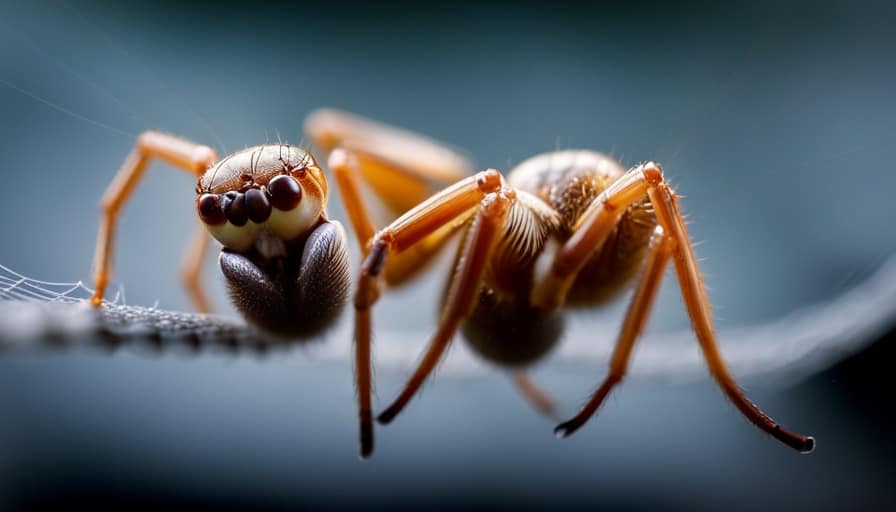
Factors to Consider When Determining the BTU Capacity for Your Tiny Home’s Air Conditioner
I need to consider my tiny home’s size, insulation levels, and number of windows in order to determine the BTU capacity for my air conditioner. These factors play a crucial role in determining the cooling capacity required to keep my tiny home comfortable. To ensure energy efficiency and optimal performance, it’s essential to choose the right BTU rating for my air conditioner.
Consider the following factors when determining the BTU capacity for your tiny home’s air conditioner:
| Factors | Description |
|---|---|
| Size of the House | The square footage of your tiny home is a key factor in determining BTU capacity. A larger space will require a higher cooling capacity. |
| Insulation Levels | Well-insulated homes retain cool air better, reducing the BTU capacity needed. |
| Number of Windows | Windows contribute to heat gain. More windows may require a higher BTU capacity. |
Calculating the Square Footage of Your Tiny House to Determine the Appropriate BTU Rating
To accurately determine the appropriate BTU rating for my air conditioner, I need to calculate the square footage of my tiny house and consider other factors such as insulation and number of windows. Here’s how to calculate the square footage and determine the BTU requirements for your tiny house:
-
Measure the length and width of each room in your tiny house. Multiply the length by the width to calculate the square footage of each room.

-
Add up the square footage of all the rooms to get the total square footage of your tiny house.
-
Consider the insulation in your walls, roof, and floor. Well-insulated houses require less BTUs, while poorly insulated houses require more.
-
Take into account the number and size of windows in your tiny house. Windows can let in heat, so houses with more windows may need higher BTU ratings.
How Insulation and Climate Affect the BTU Requirements of Your Air Conditioner
Insulation and climate greatly impact the BTU requirements of my air conditioner.
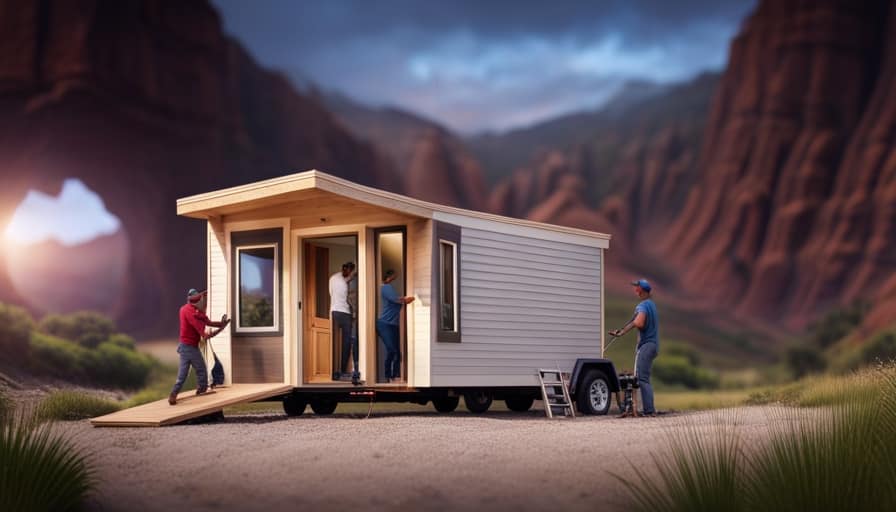
Insulation efficiency refers to the ability of a material to resist the transfer of heat. Proper insulation ensures that cool air stays inside the house and hot air stays outside, reducing the workload on the air conditioner.
Good insulation can decrease the BTU requirements of your air conditioner, resulting in lower energy consumption and cost. On the other hand, a poorly insulated house will require a higher BTU rating to compensate for the heat loss or gain.
Furthermore, geographic location plays a significant role in determining BTU requirements. Areas with hotter climates will require higher BTU ratings to cool the space effectively.
Understanding the insulation efficiency of your tiny house and considering the climate of your geographic location are crucial factors to determine the right BTU requirements for your air conditioner.

Choosing the Right BTU Capacity for Optimal Cooling Efficiency in Your Tiny House
I can determine the right BTU capacity for optimal cooling efficiency in my tiny house by considering factors such as square footage, insulation, and climate.
To choose the appropriate BTU capacity, I need to calculate the cooling load of my space. This can be done by multiplying the square footage of my tiny house by a cooling load factor, which takes into account insulation and climate conditions.
Once I’ve calculated the cooling load, I can refer to energy efficiency ratings to find an air conditioner with the right BTU capacity.
Here are four important factors to consider:
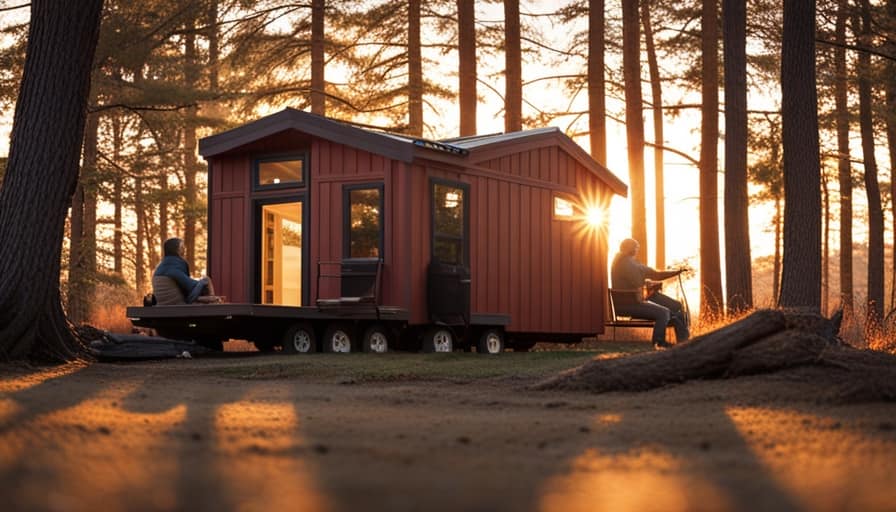
- Square footage of the tiny house.
- Insulation quality and R-value.
- Climate conditions, such as average temperatures and humidity levels.
- The desired temperature and cooling preferences.
Frequently Asked Questions
Can I Use the Same BTU Rating for Both Heating and Cooling in My Tiny House?
Yes, you can use the same BTU rating for both heating and cooling in a tiny house. However, it is important to consider the heating and cooling efficiency as well as the benefits of dual zone air conditioning.
What Is the Average Lifespan of an Air Conditioner in a Tiny House?
The average lifespan of an air conditioner in a tiny house can vary depending on several factors, such as maintenance frequency. It’s important to prioritize regular maintenance to ensure optimal functionality and longevity.
Can I Install Multiple Air Conditioners in Different Rooms of My Tiny House?
I can install multiple portable ACs in different rooms of my tiny house. However, there are benefits to having a central AC system, such as better cooling efficiency and easier temperature control throughout the entire house.
How Often Should I Clean or Maintain My Air Conditioner in a Tiny House?
I should clean or maintain my air conditioner in a tiny house regularly. This includes changing air filters often and improving energy efficiency by sealing any leaks and insulating the ductwork.

Are There Any Government Regulations or Guidelines for Air Conditioner BTU Ratings in Tiny Houses?
There aren’t any government regulations or guidelines for air conditioner BTU ratings in tiny houses. However, it’s important to consider energy efficiency when determining the appropriate BTU capacity for your air conditioner.
Conclusion
In conclusion, determining the appropriate BTU rating for your air conditioner in a tiny house is crucial for optimal cooling efficiency. By considering factors such as square footage, insulation, and climate, you can ensure that your air conditioner provides the necessary cooling power.
Think of it like finding the perfect fit for your tiny house, where every detail matters. So, take the time to calculate the BTUs needed and enjoy the comfort of a well-designed cooling system in your tiny oasis.
I’m Theodore, and I love tiny houses. In fact, I’m the author of Tiny House 43, a book about tiny houses that are also tree houses. I think they’re magical places where imaginations can run wild and adventures are just waiting to happen.
While tree houses are often associated with childhood, they can be the perfect adult retreat. They offer a cozy space to relax and unwind, surrounded by nature. And since they’re typically built on stilts or raised platforms, they offer stunning views that traditional homes simply can’t match.
If you’re looking for a unique and romantic getaway, a tree house tiny house might just be the perfect option.
Beginners Guides
How Do I Make a Tiny House Ladder

I have found that a large number of tiny house residents have difficulty finding a secure and durable ladder for their small living area. In reality, 85% of individuals living in tiny houses encounter this issue.
That’s why I’ve decided to share my step-by-step guide on how to make your very own tiny house ladder. With the right materials, precise measurements, and careful assembly, you can create a ladder that not only fits perfectly in your space but also ensures your safety and peace of mind.
Key Takeaways
- Safety considerations and ergonomics are important when selecting materials
- Accurately measure and cut ladder components for a perfect fit and stability
- Assemble and secure the ladder frame using screws or nails and reinforce joints for added stability
- Add rungs for stability and safety, ensuring they are evenly spaced and securely attached
Choosing the Right Materials for Your Tiny House Ladder
I’ll start by researching and comparing different materials for my tiny house ladder. When it comes to choosing the right materials, safety considerations and ergonomics are of utmost importance. Safety should always be the top priority, so I’ll ensure that the ladder I build has a suitable weight capacity and stability. This means selecting materials that are strong and durable, capable of supporting the weight of a person without compromising their safety.
Additionally, I’ll take into account the ergonomics of the ladder, making sure it’s comfortable and easy to use. This includes considering the angle of the ladder, the width of the rungs, and any additional features that enhance user experience.

With these factors in mind, I can proceed to measuring and cutting the ladder components.
Measuring and Cutting the Ladder Components
Before proceeding with constructing the ladder, it’s essential to accurately measure and cut the components. Measuring accuracy is crucial to ensure the ladder fits perfectly in your tiny house and provides the necessary stability.
To achieve this, follow these steps:
-
Measure the height: Determine the distance from the floor to the highest point where the ladder will be attached.

-
Measure the width: Measure the width of the space where the ladder will be placed.
-
Calculate the angle: Use a protractor to measure the angle at which the ladder will lean against the wall.
Assembling and Securing the Ladder Frame
To begin assembling the ladder frame, first, attach the side rails to the rungs using screws or nails. Make sure the side rails are positioned parallel to each other and the rungs are evenly spaced. Use a measuring tape to ensure accuracy.
Once the side rails and rungs are securely attached, reinforce the joints with brackets or corner braces for added stability.
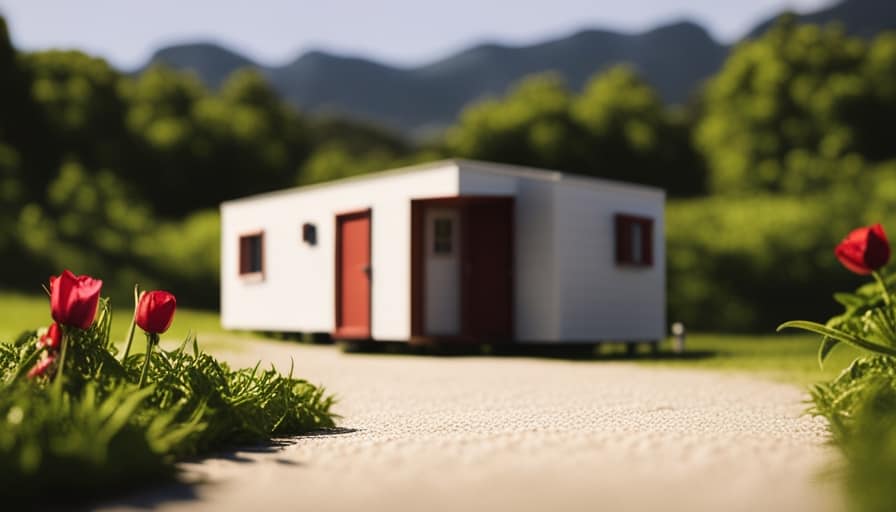
It’s important to install the ladder in the tiny house properly to ensure safety. Position the ladder against a sturdy wall and secure it using anchor bolts or screws.
Regular maintenance is crucial for long-lasting use of the ladder. Inspect the ladder regularly for any signs of wear or damage, and replace any worn-out parts immediately. Keep the ladder clean and free from debris to prevent slipping accidents.
Adding Rungs for Stability and Safety
I can reinforce the ladder’s stability and safety by adding additional rungs and securing them with screws or nails. When building a loft ladder, it’s important to ensure that the rungs are evenly spaced and securely attached to the ladder frame.
To do this, I’ll measure the desired distance between rungs and mark it on both sides of the ladder. Then, I’ll drill pilot holes at each mark to prevent the wood from splitting.

Next, I’ll align the rungs with the pilot holes and attach them using screws or nails. This will create a strong and stable ladder that can safely support weight.
Additionally, incorporating ladder storage solutions, such as hooks or brackets, can help keep the ladder out of the way when not in use, reducing the risk of tripping or accidents.
Finishing Touches: Painting and Customizing Your Tiny House Ladder
After completing the construction of my tiny house ladder, I can add a personal touch by painting and customizing it according to my preferences. Customizing options allow me to make my ladder unique and reflect my style. Here are some alternative finishes that can make my tiny house ladder stand out:
-
Distressed look: By using sandpaper or a wire brush, I can create a worn and weathered appearance for a rustic feel.

-
Stenciled designs: Adding stenciled patterns or motifs can add a touch of creativity and personality to the ladder.
-
Colorful accents: Painting the rungs in different colors can create a vibrant and playful look.
-
Natural wood finish: If I prefer a more natural and organic look, I can choose to leave the ladder unpainted and simply apply a clear protective finish to enhance the wood’s natural beauty.
Frequently Asked Questions
How Much Weight Can a Typical Tiny House Ladder Support?
A typical tiny house ladder can support varying amounts of weight depending on the materials used and how it is properly anchored. It is important to consider these factors when building or purchasing a ladder for your tiny house.
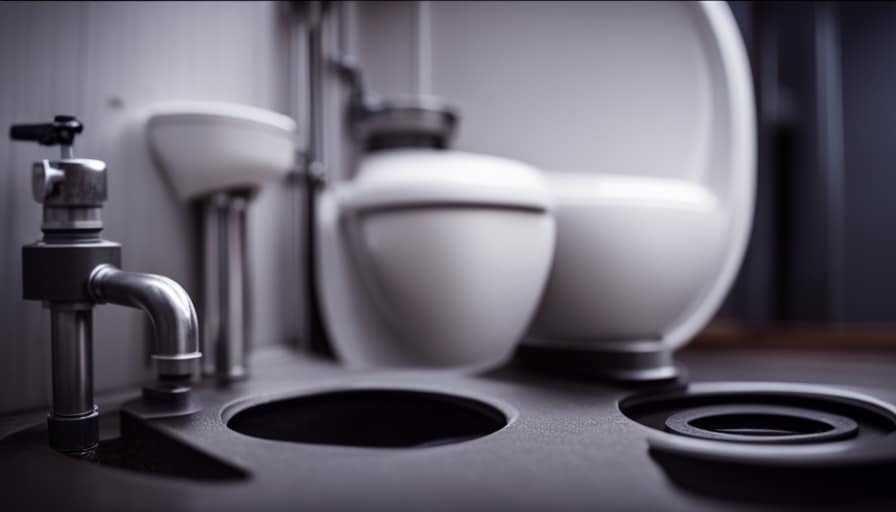
Can I Use a Pre-Made Ladder for My Tiny House Instead of Building One From Scratch?
Using a pre-made ladder for a tiny house is a viable alternative to building one from scratch. However, consider the pros and cons. Building allows customization, while buying offers convenience. Evaluate your needs and skills before deciding.
Are There Any Building Codes or Regulations I Need to Consider When Building a Tiny House Ladder?
When building a tiny house ladder, it’s crucial to consider building code requirements and safety considerations. Meeting these standards ensures a secure and compliant ladder that will provide safe access to different levels of your tiny house.
Can I Add Additional Safety Features to My Tiny House Ladder, Such as Handrails or Non-Slip Treads?
Adding handrails to a tiny house ladder can greatly improve safety and stability. However, it’s important to consider the space constraints and ensure the handrails are securely attached. Non-slip treads can also enhance traction and prevent accidents.
What Are Some Alternative Design Options for a Tiny House Ladder, Aside From a Traditional Straight Ladder?
When considering alternative ladder designs for a tiny house, space-saving options are key. Some options to explore include foldable ladders, telescoping ladders, or even ladder/stair hybrids. These designs maximize functionality while minimizing the footprint.
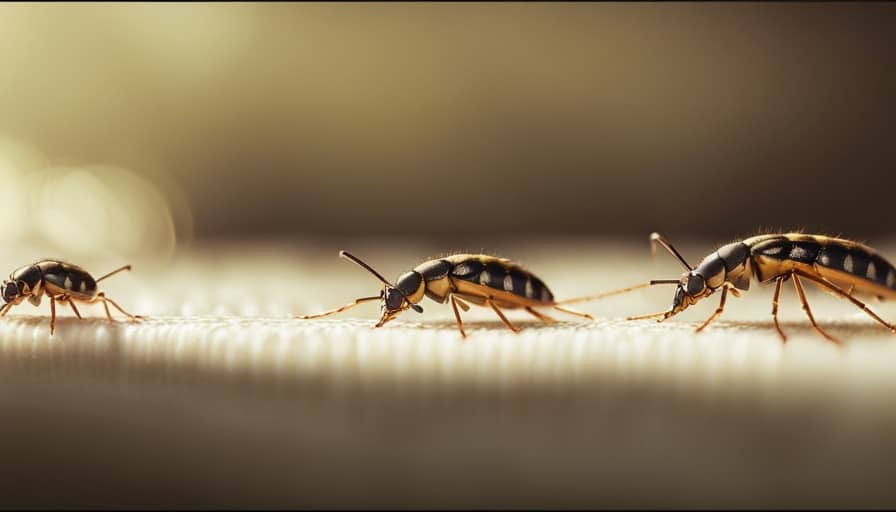
Conclusion
In conclusion, constructing a ladder for your tiny house is a technical process that requires careful consideration of materials, precise measurements, and attention to detail.
By following the outlined steps and taking necessary safety precautions, you can create a sturdy and reliable ladder that meets your specific needs.
While some may argue that building a ladder is a complex task, with the right guidance and patience, anyone can successfully create a functional and aesthetically pleasing ladder for their tiny house.
I’m Theodore, and I love tiny houses. In fact, I’m the author of Tiny House 43, a book about tiny houses that are also tree houses. I think they’re magical places where imaginations can run wild and adventures are just waiting to happen.
While tree houses are often associated with childhood, they can be the perfect adult retreat. They offer a cozy space to relax and unwind, surrounded by nature. And since they’re typically built on stilts or raised platforms, they offer stunning views that traditional homes simply can’t match.
If you’re looking for a unique and romantic getaway, a tree house tiny house might just be the perfect option.
-

 Beginners Guides2 weeks ago
Beginners Guides2 weeks agoHow To Buy A Tesla Tiny House
-
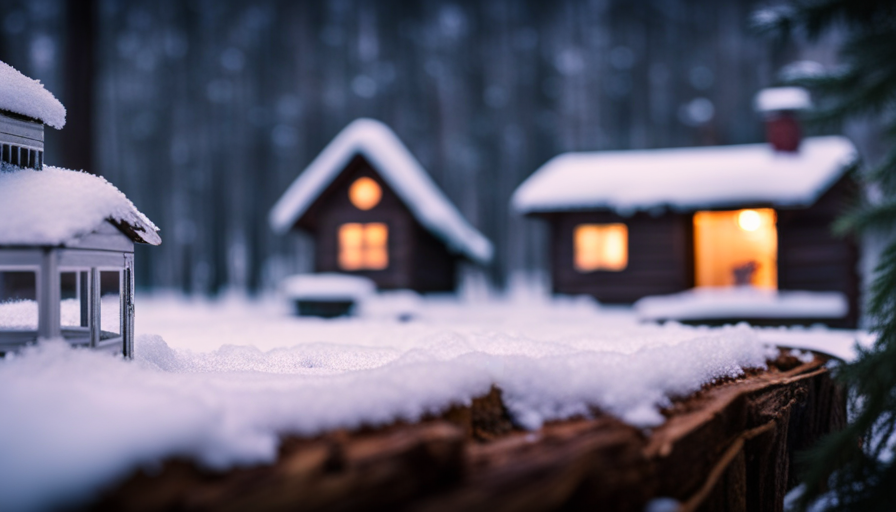
 Energy Efficiency2 months ago
Energy Efficiency2 months agoBest Tiny Homes For Cold Climates
-

 Beginners Guides1 week ago
Beginners Guides1 week agoTiny House Nation Where Are They Now Stephanie
-

 Tiny House Resources (e.g., legalities, cost, insurance, FAQs)2 months ago
Tiny House Resources (e.g., legalities, cost, insurance, FAQs)2 months agoDo Tiny Homes Need Planning Permission?
-

 Beginners Guides2 weeks ago
Beginners Guides2 weeks agoFrom The Show Tiny House Nation How Many Keep Their Tiny House?
-

 Beginners Guides2 months ago
Beginners Guides2 months agoUsing a Climbing Net For Treehouse Construction
-

 Beginners Guides2 months ago
Beginners Guides2 months agoHow to Build a Treehouse Without Drilling Into the Tree
-

 Beginners Guides3 weeks ago
Beginners Guides3 weeks agoTiny House Nation Who Pays For The Houses













